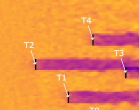Battery#
There are two battery models currently implemented in Hercules: BatterySimple and BatteryLithiumIon.
Sign Conventions#
It is important to note that within the battery modules, the convention that positive power is charging the
battery is followed for consistency with battery standards. However, at the level of the HybridPlant
this is inverted, such that positive power implies power delivery (and thus the battery is discharging)
for consistency with other components. This inversion applies to power_setpoint and also occurs within
HybridPlant.
Parameters#
Battery parameters are defined in the hercules input yaml file used to initialize HerculesModel.
Required Parameters#
component_type:"BatterySimple"or"BatteryLithiumIon"energy_capacity: Energy capacity in kWhcharge_rate: Maximum charge rate in kWdischarge_rate: Maximum discharge rate in kWmax_SOC: Maximum state of charge (between 0 and 1)min_SOC: Minimum state of charge (between 0 and 1)initial_conditionsSOC: Initial state of charge (betweenmin_SOCandmax_SOC)
Optional Parameters#
allow_grid_power_consumption: True or False (defaults to False)roundtrip_efficiency: Roundtrip efficiency (0-1, applies to BatterySimple only)self_discharge_time_constant: Self-discharge time constant in seconds (BatterySimple only)track_usage: Enable usage tracking for degradation modeling (BatterySimple only)usage_calc_interval: Interval for usage calculations in seconds (BatterySimple only)usage_lifetime: Battery lifetime in years for time-based degradation (BatterySimple only)usage_cycles: Number of cycles until replacement for cycle-based degradation (BatterySimple only)log_channels: List of output channels to log (see Logging Configuration below)
Once initialized, the battery is only interacted with using the step method.
Inputs#
Inputs are passed to step() as a dict named h_dict, which must have the following fields:
h_dict = {
"battery": {
"power_setpoint": 1000 # Requested battery power in kW (positive=discharge, negative=charge)
},
"plant": {
"locally_generated_power": 5000 # Available power for charging in kW
}
}
Outputs#
Outputs are returned as a dict containing the following values:
power: Actual battery power in kWreject: Rejected power due to constraints in kW (positive when power cannot be absorbed, negative when required power unavailable)soc: Battery state of charge (0-1)power_setpoint: Requested power setpoint in kW
Additional Outputs (BatterySimple only when track_usage=True)#
usage_in_time: Time-based usage percentageusage_in_cycles: Cycle-based usage percentagetotal_cycles: Total equivalent cycles completed
Logging Configuration#
The log_channels parameter controls which outputs are written to the HDF5 output file. This is a list of channel names. The power channel is always logged, even if not explicitly specified.
Available Channels:
power: Actual battery power output in kW (always logged)soc: State of charge (0-1)power_setpoint: Requested power setpoint in kW
Example:
battery:
component_type: BatterySimple
energy_capacity: 100.0 # kWh
charge_rate: 50.0 # kW
discharge_rate: 50.0 # kW
max_SOC: 0.9
min_SOC: 0.1
log_channels:
- power
- soc
- power_setpoint
initial_conditions:
SOC: 0.5
If log_channels is not specified, only power will be logged.
BatterySimple#
BatterySimple is a basic energy storage model with the following features:
Energy Integration: \(E_t = \sum_{k=0}^t P_k \Delta t\), where \(E_t\) is the energy stored and \(P_t\) is the charging/discharging power at time \(t\)
Efficiency Losses: Separate charge and discharge efficiencies (from roundtrip efficiency)
Self-Discharge: Exponential energy loss with configurable time constant
Usage Tracking: Optional rainflow cycle counting for degradation modeling
Constraints: Both energy and power are constrained by upper and lower limits:
\(\underline{E} \leq E \leq \overline{E}\)
\(\underline{P} \leq P \leq \overline{P}\)
The model uses a state-space representation to handle self-discharge and efficiency losses in a unified framework.
BatteryLithiumIon#
BatteryLithiumIon models a detailed lithium-ion battery using an equivalent circuit model based on [1]. Key features include:
Equivalent Circuit Model: RC branch representing diffusion transients
State-Dependent Parameters: Open circuit voltage, resistance, and capacitance vary with SOC, SOH, and temperature
Cell-Level Modeling: Individual cell behavior scaled to battery pack
Voltage-Current Relationship: Iterative power control accounting for voltage variations
Physical Constraints: Energy, power, and current limits at cell and pack level
Battery Specifications:
Cathode Material: LiFePO4
Anode Material: Graphite
Nominal Cell Voltage: 3.3V
Cell Capacity: 15.756 Ah
The main difference from BatterySimple is the inclusion of voltage dynamics, diffusion transients, and state-dependent equivalent circuit parameters that provide higher fidelity modeling of lithium-ion battery behavior.
References#
M.-K. Tran et al., “A comprehensive equivalent circuit model for lithium-ion batteries, incorporating the effects of state of health, state of charge, and temperature on model parameters,” Journal of Energy Storage, vol. 43, p. 103252, Nov. 2021, doi: 10.1016/j.est.2021.103252.
